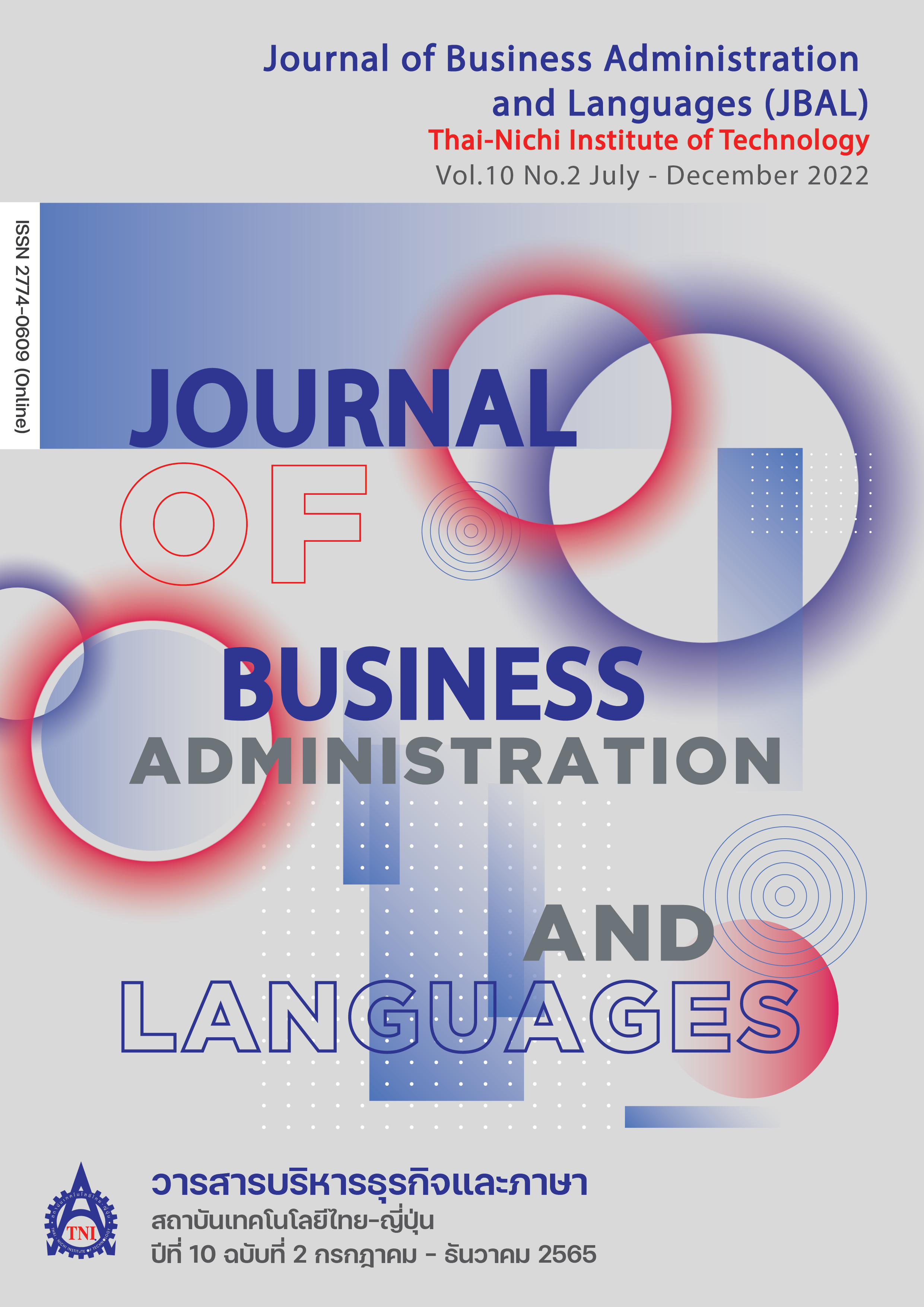ปัจจัยที่มีอิทธิพลต่อพฤติกรรมการทำงานเชิงนวัตกรรมของพนักงานในอุตสาหกรรมการบริการด้านการผลิตอุปกรณ์อิเล็กทรอนิกส์ ในเขตนิคมอุตสาหกรรมแหลมฉบัง จังหวัดชลบุรี
Main Article Content
บทคัดย่อ
งานวิจัยนี้เป็นการศึกษาปัจจัยที่มีอิทธิพลต่อพฤติกรรมการทำงานเชิงนวัตกรรมของพนักงานในอุตสาหกรรมการบริการด้านการผลิตอุปกรณ์อิเล็กทรอนิกส์ เขตนิคมอุตสาหกรรมแหลมฉบัง จังหวัดชลบุรี โดยมีวัตถุประสงค์ 1) เพื่อศึกษาอิทธิพลของรูปแบบภาวะผู้นำของพนักงานที่มีผลต่อพฤติกรรมการทำงานเชิงนวัตกรรมของพนักงาน 2) เพื่อศึกษาอิทธิพลของการมอบอำนาจของพนักงานที่มีผลต่อพฤติกรรมการทำงานเชิงนวัตกรรมของพนักงาน 3) เพื่อศึกษาอิทธิพลของสภาพแวดล้อมในการทำงานที่มีผลต่อพฤติกรรมการทำงานเชิงนวัตกรรมของพนักงาน กลุ่มตัวอย่างเป็นพนักงานที่ทำงานในองค์การในอุตสาหกรรมการบริการด้านการผลิตอุปกรณ์อิเล็กทรอนิกส์ เขตนิคมอุตสาหกรรมแหลมฉบัง จังหวัดชลบุรี จำนวนกลุ่มตัวอย่าง 374 คน จากสูตรการคำนวณกลุ่มตัวอย่างของ Yamane ที่ระดับความเชื่อมั่นร้อยละ 95 เครื่องมือที่ใช้คือ แบบสอบถาม สถิติที่ใช้คือ สัมประสิทธิ์สหสัมพันธ์ของเพียร์สัน (Pearson’s Product Moment Coefficient) และการวิเคราะห์การถดถอยพหุคูณแบบขั้นตอน (Stepwise Multiple Regression Analysis) ผลการวิจัยพบว่า ปัจจัยที่มีอิทธิพลต่อพฤติกรรมการทำงานเชิงนวัตกรรมของพนักงาน คือปัจจัยรูปแบบภาวะผู้นำ จากตัวชี้วัดด้านภาวะผู้นำการแลกเปลี่ยน ปัจจัยการมอบอำนาจของพนักงาน คือตัวชี้วัดด้านการกำหนดใจตนเอง ด้านผลกระทบ และด้านสมรรถนะ ปัจจัยสภาพแวดล้อมในการทำงาน คือตัวชี้วัดด้านสภาพแวดล้อมทางจิตวิทยาและสภาพแวดล้อมทางสังคม ที่มีผลในทางบวกอย่างมีนัยสำคัญทางสถิติ 0.05 ซึ่งการวิจัยในครั้งนี้จะเป็นประโยชน์ในการนำไปใช้เป็นแนวทางเบื้องต้นในการพัฒนาบุคลากรในองค์การ เพื่อส่งเสริมการทำงานเชิงนวัตกรรม ให้พนักงานและองค์การได้ผลประโยชน์สูงสุด
Article Details

อนุญาตภายใต้เงื่อนไข Creative Commons Attribution-NonCommercial-NoDerivatives 4.0 International License.
นโยบายการรับบทความ
กองบรรณาธิการวารสารสถาบันเทคโนโลยีไทย-ญี่ปุ่น มีความยินดีรับบทความจากอาจารย์ นักศึกษา และผู้ทรงคุณวุฒิในสาขาบริหารธุรกิจและภาษา ที่เขียนเป็นภาษาไทยหรือภาษาอังกฤษ ซึ่งผลงานวิชาการที่ส่งมาขอตีพิมพ์ต้องไม่เคยเผยแพร่ในสิ่งพิมพ์อื่นใดมาก่อน และต้องไม่อยู่ในระหว่างการพิจารณาของวารสารอื่นที่นำส่ง ดังนั้นผู้สนใจที่จะร่วมเผยแพร่ผลงานและความรู้ที่ศึกษามาสามารถนำส่งบทความได้ที่กองบรรณาธิการเพื่อเสนอต่อคณะกรรมการกลั่นกรองบทความพิจารณาจัดพิมพ์ในวารสารต่อไป ทั้งนี้บทความที่สามารถเผยแพร่ได้ประกอบด้วยบทความวิจัย ผู้สนใจสามารถศึกษาและจัดเตรียมบทความจากคำแนะนำสำหรับผู้เขียนบทความ
การละเมิดลิขสิทธิ์ถือเป็นความรับผิดชอบของผู้ส่งบทความโดยตรง บทความที่ได้รับการตีพิมพ์ต้องผ่านการพิจารณากลั่นกรองคุณภาพจากผู้ทรงคุณวุฒิและได้รับความเห็นชอบจาก กองบรรณาธิการ
ข้อความที่ปรากฏภายในบทความของแต่ละบทความที่ตีพิมพ์ในวารสารวิชาการเล่มนี้ เป็น ความคิดเห็นส่วนตัวของผู้เขียนแต่ละท่าน ไม่เกี่ยวข้องกับสถาบันเทคโนโลยีไทย-ญี่ปุ่น และคณาจารย์ท่านอื่น ๆ ในสถาบัน แต่อย่างใด ความรับผิดชอบด้านเนื้อหาและการตรวจร่างบทความแต่ละบทความเป็นของผู้เขียนแต่ละท่าน หากมีความผิดพลาดใด ๆ ผู้เขียนแต่ละท่านจะต้องรับผิดชอบบทความของตนเองแต่ผู้เดียว
กองบรรณาธิการขอสงวนสิทธิ์มิให้นำเนื้อหา ทัศนะ หรือข้อคิดเห็นใด ๆ ของบทความในวารสารวิชาการ สถาบันเทคโนโลยีไทย-ญี่ปุ่น ไปเผยแพร่ก่อนได้รับอนุญาตจากผู้นิพนธ์อย่างเป็นลายลักษณ์อักษร ผลงานที่ได้รับการตีพิมพ์ถือเป็นลิขสิทธิ์ของวารสารสถาบันเทคโนโลยีไทย-ญี่ปุ่น
หากต้องการสอบถามข้อมูลเพิ่มเติมที่
- กองบรรณาธิการ วารสารสถาบันเทคโนโลยีไทย-ญี่ปุ่น
- ฝ่ายวิจัยและนวัตกรรม สถาบันเทคโนโลยีไทย-ญี่ปุ่น
เลขที่ 1771/1 สถาบันเทคโนโลยีไทย-ญี่ปุ่น ซอยพัฒนาการ 37-39 ถนนพัฒนาการ แขวงสวนหลวง เขตสวนหลวง กรุงเทพมหานคร 10250 ติดต่อกับคุณพิมพ์รต พิพัฒนกุล (02) 763-2752 , คุณอาริสา จิระเวชถาวร (02) 763-2600 Ext. 2704 Fax. (02) 763-2754 หรือ E-mail: JBAL@tni.ac.th
เอกสารอ้างอิง
Agbozo, K. G., Owusu, I. S., Hoedoafia, M. A., & Atakorah, Y. B. (2017). The effect of work environment on job satisfaction. Journal of Human Resource Management, 5(1), 12–18.
Alheet, A. F., Adwan, A. A., Areiqat, A. Y., Zamil, A., & Saleh, M. (2021). The effect of leadership styles on employees' innovative work behavior. Management Science Letters, 11(1), 239–246.
Alkhodary, D. (2016). The relationship between employees’ empowerment and innovative work behavior. International Journal of Managerial Studies and Research, 4(2), 1–15.
Baruch, D. W. (1968). New Ways in Discipline. New York, NY: Randon House.
Bowen, D. E., & Lawler, E. E. (1992). The empowerment of service workers: What, why, how, and when. Sloan Management Review, 33(3), 31–39.
Burns, J. M. (1978). Leadership. New York, NY: Harper and Row.
Demesko, N. (2017). Effects of transformational and transactional leadership styles on innovative work behavior: The role of employee's locus of control (Master’s thesis). Retrieved from https://vb.ism.lt/object/elaba:20108163/
Department of International Trade Promotion. (2019, January 26). Electronics Intelligence Industry (in Thai). Retrieved from https://onestopservice.ditp.go.th/index/view_news/58
Dujdaw Duangden. (2015, May 27). Organization creation with Human-Centered Productivity (in Thai). Retrieved from https://www.ftpi.or.th/2015/3474
Dul, J., & Ceylan, C. (2011). Work environments for employee creativity. Ergonomics, 54(1), 12–20.
Global Innovation Index. (2020). Explore The Interactive Database of The GII 2020 Indicators. Retrieved from https://www.globalinnovationindex.org/analysis-indicator
Gorny, A. (2017). The use of working environment factors as criteria in assessing the capacity to carry out processes. MATEC Web of Conferences, 94, 1–11.
Gouran, D. S., Weithoff, W. E., & Doeler, J. A. (1994). Mastering Communication (2nd Ed.). Boston: Allyn & Bacon.
Helmy, I., Adawiyah, W. R., & Banani, A. (2019). Linking psychological empowerment, knowledge sharing, and employees’ innovative behavior in Indonesian SMEs. The Journal of Behavioral Sciences, 14(2), 66–79.
Jong, J. D., & Hartog, D. D. (2010). Innovative work behavior: Measurement and validation. Creativity and Innovation Management, 19(1), 23–36.
Khan, M. J., & Aslam, N. (2012). Leadership styles as predictors of innovative work behavior. Pakistan Journal of Social and Clinical Psychology, 10(1), 17–22.
Kimolo, K. (2013). The relationship between employee empowerment practices and employee performance in regional development authorities in Kenya (Master’s thesis). Retrieved from http://erepository.uonbi.ac.ke/handle/11295/60661
National Science and Technology Development Agency. (2019, February 4). Learning Organization…How to know? (in Thai). Retrieved from www.nstda.or.th/home/knowledge_post/learning-organization
Natthakan Thitichamroenphorn, & Kanyakit Keerati-angkoon. (2018). Factors affecting employee’s innovation behavior in Toyota Daihatsu Engineering & Manufacturing Co., Ltd (in Thai). Veridian E-Journal, Silpakorn University, 11(2), 651–669.
Naqvi, J. A., Ullah, S., & Javed, B. (2017). Effect of leadership styles on employees’ innovative behaviour: The mediating role of employees’ creativity. European Journal of Business and Management, 9(28), 27–37.
Noppawan Khananurak. (2011). Conceptual of internal marketing and employee empowerment (in Thai). Quality Marketing and Branding, 17(159), 85–88.
Notar, C. E., Uline, C. S., & Eady, C. K. (2008). What makes an “Effective” leader: The application of leadership. International Education Studies, 1(3), 25–29.
Perkins, D. D, & Zimmerman, M. A. (1995). Empowerment theory, Research, and Application. American Journal of Community Psychology, 23(5), 569–579.
Pornchai Jedaman. (2017). Change Leadership 21st Century : Thailand 4.0 (in Thai). Retrieved from https://www.kroobannok.com/83312
Prawech Chumkesornkulkit & Sageemas Na Wichian. (2018). Innovative work behavior: Concept, antecedents and challenges (in Thai). Journal of Behavioral Science for Development (JBSD), 10(1), 25–41.
Sharma, M. K., & Jain, S. (2013). Leadership management: Principles, models and theories. Global Journal of Management and Business Studies, 3(3), 309–318.
Siwaporn Proyanont. (2011). Leader Behaviors and Work Environments that Affect Creativity at Work: A Case Study of Thailand's Most Innovative Companies 2009 (in Thai). (Master’s thesis). Retrieved from https://repository.nida.ac.th/handle/662723737/639#
Smith, M. D. (2011). The ecological role of climate extremes: current understanding and future prospects. Journal of Ecology, 99(3), 651–655.
Spreitzer, G. M. (1995). Psychological Empowerment in the workplace: Dimensions, measurement and validation. Academy of Management Journal, 38(5), 1442–1465.
Yamane, T. (1973). Statistics: An Introductory Analysis (3rd ed.). New York, NY: Harper and Row.


